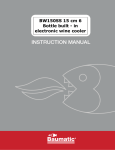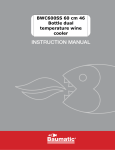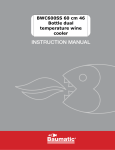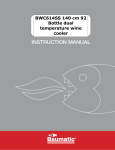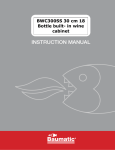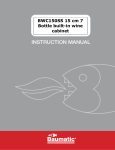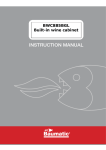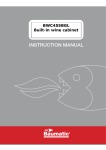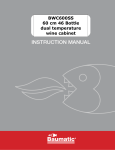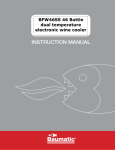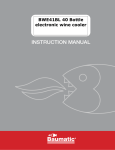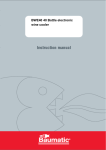Download Baumatic BW300SS drink cooler
Transcript
BW300SS 30 cm 12 Bottle built- in electronic wine cooler USER MANUAL FOR YOUR BAUMATIC BW300SS 30 cm 12 Bottle built-in electronic wine cooler NOTE: This User Instruction Manual contains important information, including safety & installation points, which will enable you to get the most out of your appliance. Please keep it in a safe place so that it is easily available for future reference, for you or any person not familiar with the operation of the appliance. DD 24/12/09 2 Contents Environmental note 4 Important safety information 5–6 Specifications of your wine cooler 7–8 Description of the appliance Control panel Description of the product features 8-10 8 9-10 Using your Baumatic wine cooler Before switching on During first use Switching on the appliance and setting the temperature Loading the wine cooler 10-12 10 10 11 12 Storing your wines Wine storage problems 12-14 14-15 Cleaning and maintenance Defrosting 15-16 16 Installation Electrical connection Positioning Built-in installation Reversing the door of your wine cooler 16-21 16-17 17-18 18 19-21 Troubleshooting 22-24 Contact details 25 3 Environmental note Note: Before discarding an old appliance, switch off and disconnect it from the power supply. Cut off and render any plug useless. Cut the cable off directly behind the appliance to prevent misuse. This should be undertaken by a competent person. Disable the door lock to make sure that children cannot get stuck inside the appliance. o The packaging materials that Baumatic uses are environmentally friendly and can be recycled. o Please discard all packaging material with due regard for the environment. 4 Important safety information Your safety is of the utmost importance to Baumatic. Please make sure that you read this instruction booklet before attempting to install or use the appliance. If you are unsure of any of the information contained in this booklet, please contact the Baumatic Advice Line. IMPORTANT: Any installation work must be carried out by a qualified electrician or competent person. Use of the appliance o Your appliance is only designed to be used in the home. It is suitable for storing and chilling wine. NO food stuffs must be stored in the appliance. If it is used for any other purpose or it is not used correctly, then Baumatic Ltd. will accept no liability for any damage that is caused. o Altering the specification of the appliance must not be attempted for reasons of safety. Before using your appliance o Check the appliance for any signs of transport damage. If you notice any damage, then you should not connect your appliance to your mains supply and should contact your retailer. Refrigerant o Your appliance contains R600a refrigerant, which is a natural gas that does not contain CFCs that can damage the environment. However it is a flammable substance, therefore care should be taken: During the transportation and installation of the appliance, make sure that the refrigeration pipework does not get damaged. If it does become damaged then sources of ignition and open flames should be avoided. Also the room that the appliance is situated in should be thoroughly ventilated. o Do not place any objects on top of the appliance, as this may damage the table top. 5 Child safety o Packaging material should be kept away from children. o Children should not be allowed to touch the controls or play with the appliance. General safety o Do not pull on the power supply cable to remove the plug from your mains supply socket. o Do not pull out or insert the plug with wet hands. o Do not attempt to use your appliance outdoors or any place where it is likely to come into contact with the elements. o Before cleaning the appliance or performing maintenance work, ensure that the appliance disconnected from your mains supply. has been o Never allow the back coils of the appliance to come into contact with the wall surface. o Always ensure that the location where you are installing your appliance is free of stored items such as papers and other flammable materials. o Never block the ventilation openings of the appliance, either on the inside or its exterior. o It is vital to keep your appliance well ventilated, so that there is proper air flow between the bottom of the unit and the plinth/kick plate which it is sitting on. o Do not place electrical devices inside of the appliance, such as mixers or ice cream makers. Service You should not attempt to repair the appliance yourself, as this could cause injury or a more serious malfunction. If you require a service call then please contact the Customer Care Department. 6 Specifications of your wine cooler Congratulations on purchasing a Baumatic wine cooler Dimensions of appliance Dimensions of aperture* Height: Width: Depth: Height: Width: Depth: o o o o o o o o o o o o 820 - 890 mm 295 mm 550 mm 820 - 890 mm 300 mm (min) 553 mm (min) Gross capacity: 55 litres Net capacity: 52 litres Bottle capacity: 12 x 0.75 litre wine bottles Electronic push button control operation LED display 4 Wooden shelves Adjustable temperature Internal white LED light One temperature zone: Adjustable feet Smoked glass door Stainless steel door frame o 1 temperature zone: 4 – 18 °C * Please refer to the installation instructions for more specific information on the size of aperture that you will require. 7 IMPORTANT: When you install your appliance it is important to bear in mind its climatic rating. In order to find out the climatic rating of your appliance, you should check the rating plate. The rating plate is located on the rear or inside of the appliance. The rating plate will indicate the ambient temperature range that your appliance will function correctly within. It is also advisable to make a note of the model number and the serial number of the appliance before installing it. Model number ……………………………………………… Serial number ……………………………………………… Date of purchase …………………………………………….. Description of the appliance Control panel The control panel is located at the top of the appliance, behind the glass door. 1) 2) 3) 4) 5) 6) 7) 8) Light ON/OFF button Temperature setting button Warning alarm indicator Compressor running indicator LED display Temperature display Temperature increase button Temperature decrease button 8 Description of the product features 1) Control panel o The control panel is located at the top of the appliance, behind the glass door. This means it is easy to set the temperature of the appliance and see what temperature the appliance is set to. 2) One cooling zone o There is one cooling zone inside of your wine cooler. o The cooling zone has a temperature control and temperature display. 3) Interior light o The cooling zone has an interior light. The light can be switched on and off by using the light ON/OFF button (1). o If you do not switch the interior light off using the light ON/OFF button, the appliance will switch the light off automatically after 5 minutes. 4) The wine cooler shelves o The full depth shelves will fit into the slots in the cabinet of the wine cooler. 5) Compressor running indicator o When the compressor is running, the LCD display will show the compressor running indicator (4), which is a moving fan symbol. o Approximately every six hours, the compressor will stop running for about 30 minutes. o When the compressor is not running, the moving fan symbol will stop. 6) LED display o If you press any button on the LCD display (5), then a backlight will appear behind it. o If no other button is pressed, the appliance will switch the backlight off automatically after 5 minutes. 9 7) Error codes o If the appliance senses a problem, then an audible alarm will sound and an alarm code will show on the LCD display (5). See the error codes section of this manual for more detailed information. Using your Baumatic wine cooler Before switching on o Make sure that it has been installed by a suitably qualified person, as per the information contained in Baumatic’s installation instructions. o After delivery, wait for eight hours before connecting the appliance to your mains supply. This will allow any refrigerant gasses that may have been disturbed during the transportation process to settle. o The outside of the appliance and the removable accessories contained within it, should be cleaned with a solution of liquid detergent and water. o The interior of the appliance should be cleaned with a solution of sodium bicarbonate dissolved in lukewarm water. The interior and accessories should be thoroughly dried, after the cleaning process has been completed. o There can be an odour when you first switch on the appliance. It will lessen as the appliance starts to cool. During first use o When you first switch on the appliance, the compressor will run continuously until the wine cooler reaches a cool enough temperature. o During this period of time, you should try not to open the door frequently or place bottles inside of the appliance. o If the unit is switched off or unplugged, you must allow at least 5 minutes before restarting the appliance or reconnecting it to your mains supply. 10 Switching on the appliance and setting the temperature o After following the installation instructions contained in this booklet, connect the appliance to your mains supply. o The appliance will be preset to a temperature of 13 °C. o To adjust the operating temperature, press the temperature setting button (2). Use the temperature increase (7) and temperature decrease (8) buttons to set the temperature that you require. Each press of these buttons will adjust the temperature on the temperature display (6) by one degree. o When the temperature that you require appears on the temperature display, you should stop pressing the temperature increase and decrease buttons. Press the temperature setting button again to confirm the operating temperature. o Cool air falls and warmer air rises, so there will be a slight temperature variation between the top of the cabinet and the bottom of the cabinet. o The temperature sensor is located in the middle of the appliance and will record the temperature being maintained in this part of the appliance. The temperature at the top of the wine cooler will be slightly warmer and the temperature at the bottom of the wine cooler will be slightly colder. o If there is a power cut, when the power is restored, the appliance will remember the most recent temperature setting automatically. 11 Loading the wine cooler o IMPORTANT: Your appliance is ideally suited to store 0.75 litre wine bottles. o To fit 3 wine bottles on a shelf, you should load it in the way shown in the above drawing. o Always check that you can close the door without it fouling on a wine bottle, before shutting it. o When loading several bottles of wine at once, it will take longer for the appliance to cool the individual bottles. Storing your wines The chart below indicates the ideal storage temperatures for different types of wine:Type of wine Red wine (*) White wine (**) Sparkling wines/champagne Rose wine Vintage wine Temperature (Celsius) 15.5 – 18.5°C 10 - 15°C 7.2 – 9.5°C Temperature (Fahrenheit) 59.9 – 65.3°F 50 – 59°F 45 – 49.1°F 9.5 – 10.5°C 13°C 49.1 – 50.9°F 55°F * Light red wines, such as Beaujolais, Pinot Noir and Cabernet Franc benefit from being served slightly cooler than full-bodied reds. 12 ** Chardonnay is often served too cold. You should chill it at a warmer temperature inside of your wine cooler. Or leave it to warm slightly when you remove it from your wine cooler. o Temperature stability is the most important factor when it comes to storing wine. o Exposure to light, vibrations or fluctuations in temperature and humidity can all cause wine to spoil. When properly stored, wines not only maintain their quality but many will actually improve in aroma, flavour and complexity as they mature. o Wines kept at a higher temperature will age faster. Wine that is exposed to temperatures that are greater than 21°C (70°F) will suffer from poorer flavour and aroma. o If wine is kept at too low a temperature, this can result in the development of harmful deposits. A humidity of 70% is ideal for keeping corks from shrinking. o After a bottle of wine has been opened, the wine comes into contact with air. So it is best to store the remainder of the bottle upright, to minimize the surface area of the wine that is coming into contact with the air. o Once opened, wine will remain in a drinkable condition for two days for delicate whites or three days for rich reds, as long as the bottle as been resealed. You should make sure that the seal is firm by checking the stopper. o Special stoppers that keep wine sparking and Champagne bubbling for one or two days after opening, can be bought at most good wine shops. o When stored correctly, white wines can keep well for up to two years. Full bodied reds will age well for ten years and dessert wines will age well for up to twenty years. o When you buy a bottle of wine, you should transfer it to a suitable storage location immediately (if you are not going to store it in your wine cooler). o Cheaper bottles of wine will not age as well as more expensive ones. 13 o To make the most of the bouquet and taste of your wine, never fill more than half a glass at a time. It will also help if the shape of your wine glass is appropriate for your wine. The size and shape of your wine glass’s bowl will determine the intensity and complexity of the bouquet. The stem should be long enough to allow you to avoid hand contact with the bowl of the glass and should be tulip-shaped or tapered at the top. Wine storage problems Corking- a tiny percentage of bottled wine (about 1%) will suffer from this. The cork reacts with the wine and gives it a musty, unpleasant taste. It is the most common wine storage problem and is caused by harmless bacteria growing on the cork. As unfortunate as this is, there is nothing to do but to discard all of the wine in the affected bottle. This is not to be confused with small fragments of cork floating in the wine itself, which will not impair the flavour. Oxidisation- when wine has been opened and left for longer than a day; it tends to lose its aroma and colour, giving an overall flat taste. The only way to avoid this, it to either drink the wine on the same day it was opened or to use a vacuum device specially designed for removing oxygen from opened wine bottles. If you use such a device, the wine should still be consumed shortly afterwards. Ullage- this is loss of wine from the bottle by evaporation or leakage. Signs of ullage include wine seeping around the cork, a protruding cork or a stained label. It can happen if the bottle has been allowed to get too warm. The wine may still be drinkable, if the leakage was recent; however, you should be aware that if the wine cools down again, contraction can cause more air to be sucked into the bottle and result in further deterioration. Slight effervescence in still wine- this isn’t really a problem with the way the wine has been stored, but as a result of incomplete malolactic fermentation before the wine was bottled. A good way to get rid of the effervescence is to let the wine breathe. Alternatively you can use a bottle vacuum device, after about five minutes the effervescence will vanish. Sediment- this is not normally a problem, however both red and white wines can produce sediment after a number of months in a bottle. The sediment consists of tartrate crystals and is totally harmless. If anything the building of sediment can be considered a good sign because it means that the wine was not subjected to much (if any) filtering, meaning that the flavours and aromas should be preserved better. 14 A good way to get around sediment (if it is a problem) is to stand the bottle upright, the day before opening, so that the sediment can settle to the bottom of the bottle. You can also decant your wine; decanting will “open up” the flavour of both young and old wines, but younger wines in particular. To decant, pour the wine slowly and evenly into your decanter. Cleaning and maintenance WARNING: PLEASE ENSURE THAT YOUR APPLIANCE IS DISCONNECTED FROM YOUR MAINS SUPPLY BEFORE ATTEMPTING TO CLEAN IT. o Do not clean the appliance by pouring water onto it or spraying water over it. o The interior of the wine cooler should be cleaned periodically, using a solution of bicarbonate of soda and lukewarm water. o Clean the accessories separately with soap and water. Do not clean them in a dishwasher. o Do not use abrasive products, detergents or soaps. o After washing the appliance, wipe over the area that you have cleaned with a damp cloth and then dry it thoroughly. o When cleaning is complete, dry your hands and then reconnect the plug to your mains supply. 15 Defrosting o Defrosting occurs automatically inside of the wine cooler during operation. The defrost water is collected by the evaporating tray and evaporates automatically. o The evaporating tray and defrost water drain hole should be cleaned periodically. This will prevent water from collecting in the bottom of the wine cooler, instead of flowing down the defrost drainage channel and drain hole. o You can also pour a small amount of water down the drain hole to clean inside of it. o You should be careful to make sure that wine bottles do not touch the rear wall of the appliance, as this can interrupt the automatic defrosting process and deflect water into the base of your wine cooler. Installation IMPORTANT: Before installation and usage read all the instructions and make sure that the voltage (V) and the frequency (Hz) indicated on the rating plate are exactly the same as the voltage and frequency in your home. The rating plate can be found on the front edge of the inside of the wine cooler and/or the rear of the appliance. The manufacturer declines all responsibility in the event of the installer failing to observe all the accident prevention regulations in force, which are necessary for normal use and the regular operation of the electric system. Electrical connection YOUR WINE COOLER IS INTENDED FOR FITTED AND PERMANENT INSTALLATION. We recommend that the appliance is connected by a qualified electrician, who is a member of the N.I.C.E.I.C. and who will comply with the I.E.E. and local regulations. o Your wine cooler comes supplied with a 13 amp plug fitted. If in future you need to change the fuse in this plug, then a 13 amp ASTA approved (BS 1362) fuse must be used. 16 o The wiring in the mains lead is coloured as follows: Brown Blue Green and yellow Live Neutral Earth o As the colours of the wires in the appliance’s mains lead may not correspond with the coloured markings identifying the terminals in your spur box, please proceed as follows: The brown wire must be connected to the terminal marked “L” (live), or coloured red. The blue wire must be connected to the terminal marked “N” (neutral), or coloured black. The green and yellow wire must be connected to the terminal marked “E” (earth), or by the earth symbol, or coloured green and yellow. o When the connection is completed, no stray strands or cut wire should be present. The cord clamp must be secured over the outer sheath. Positioning o It is advisable that your appliance is only installed in a location where the ambient temperature of the room, corresponds with the climate classification that is stated on the rating plate of your appliance. Your appliance may not function correctly if the ambient temperature falls outside of the following ranges. Climate classification Appropriate ambient temperature SN +10 to +32 degrees centigrade N +16 to +32 degrees centigrade ST +18 to +38 degrees centigrade T +18 to +43 degrees centigrade o Positioning the appliance requires two people in order to avoid injuries or damage to the appliance. o Your appliance should not be located in direct sunlight or exposed to continuous heat or extremes of temperature (e.g. next to a radiator or boiler). If this is not feasible, then you should install an insulation plate between the appliance and the adjacent heat source. o You should check whether there is an electrical socket available, which will be accessible after your appliance is installed. 17 o Place the appliance flatly and firmly on a solid base. The appliance is fitted with adjustable feet, which should be used to level the appliance. o Be sure to leave enough space for the opening of the door, to avoid damage to the appliance or personal injury. o IMPORTANT: The vent at the base of the appliance is for ventilation. Nothing should be placed in front of this vent; otherwise your wine cooler may not operate properly. Built-in installation o Your wine cooler can be used as a freestanding or a built in unit. If you are going to use it as a built in unit, then the dimensions shown in the diagram above will need to be followed. o In particular the depth dimension must be observed. o IMPORTANT: The vent at the base of the appliance is for ventilation. Nothing should be placed in front of this vent; otherwise your wine cooler may not operate properly. o IMPORTANT: When building the appliance into a housing unit, YOU MUST ensure there is a 100 x 100 mm vent at the front bottom of the unit and at the bottom rear of the housing unit. 18 Reversing the door of your wine cooler This appliance has the capability of the door opening from either the left or right hand side. The unit is delivered to you with the door opening from the left side. If you want to reverse the opening direction of the door, please follow the instructions below: Any parts that you remove from the appliance whilst reversing the door, should be retained for later use. Tools required S1 = Phillips head screwdriver S2 = Flat head screwdriver 1 2 3 4 5 6 = = = = = = Hinge screws Upper left hand hinge Upper right hand hinge Upper door pin Lower hinge and pin Lower left hand hinge screws 7 = Lower right hand hinge screws 8 = Wine cooler door 19 1) Remove the hinge screws (1), upper left hand hinge (2) and upper right hand hinge (3) from the appliance, using a Phillips head screw driver (S1). 2) Remove the wine cooler door (8) from the appliance and place it onto a cushioned surface so that damage does not occur to it. 3) Remove the upper door pin (4) from the top of the door, using a flat head screwdriver (S2). 4) Remove the lower left hand hinge screws (6) and then the lower hinge and pin (5) from the right hand side of the cabinet. Then fix them onto the opposite side of the cabinet, ensuring that the screws are fully tightened. 5) Fix the upper left hand hinge (2) to the opposite side of the cabinet using the hinge screws (1), ensuring that the screws are fully tightened. 6) Fix the upper right hand hinge (3) to the opposite side of the cabinet using the hinge screws (1), ensuring that the screws are fully tightened. 7) Rotate the wine cooler door (8) through 180° and then place it onto the lower hinge and pin (5). IMPORTANT: Ensure that the pin is fully inserted into the hole in the bottom of the wine cooler door. 8) Insert the upper right hand hinge (3) into the top of the wine cooler door (8). 20 9) Place the upper door pin (4) into the hole on the left hand side of the wine cooler door (8). Tighten the upper door pin fully, using a flat head screwdriver (S2). 10) Fix the upper left hand hinge (2) to the opposite side of the cabinet using the hinge screws (1), ensuring that the screws are fully tightened. IMPORTANT: Check that the door opens and shuts correctly, without fouling, after you have completed the door reversal process. After the door has been reversed, you should check the door seal of the wine cooler. The seal should not be creased or crushed; otherwise there will be a gap between it and the inside of the door. o The seal must adhere properly all the way around the door. o If the seal is not adhering to the cabinet properly, then you should either:a) Use a warm damp cloth and manipulate the seal until it does adhere to the cabinet properly, all the way around the door. or b) Use a hair dryer on its lowest heat setting and lightly heat the areas of the door seal that are not adhering correctly. The heat will make the seal more pliable and this will allow you to manipulate the seal into the correct position. IMPORTANT: DO NOT HEAT THE DOOR SEAL ON ANYTHING BUT THE LOWEST HEAT SETTING, OR HEAT THE SEAL FOR A LONG PERIOD OF TIME. OTHERWISE DAMAGE MAY BE CAUSED TO THE DOOR SEAL, WHICH WOULD NOT BE RECTIFIED UNDER THE GUARANTEE FREE OF CHARGE. 21 Troubleshooting IMPORTANT: If your wine cooler appears not to be operating properly, before contacting the Customer Care Department, please refer to the checklist below. PROBLEM Appliance does not operate Temperature inside the appliance is too warm. Temperature inside the appliance is too cold Vibration Moisture is forming on the inside of the appliance. Moisture is forming on the outside of the appliance. POSSIBLE CAUSE Not plugged in. The circuit breaker has tripped or the fuse has blown. The temperature controls are set too warm. Set the temperature controls to a cooler setting and allow several hours for the temperature to stabilise. The door is being kept open too long or is being opened too frequently, which is allowing warm air to enter the appliance. The door is not closed completely. The door gasket is not sealing correctly. The appliance has recently been disconnected from the mains supply; it will take at least four hours for it to get down to temperature again. The temperature controls are set too cold. Set the temperature controls to a warmer setting and allow several hours for the temperature to stabilise. Check to ensure that the appliance is on a level surface. The appliance is touching the back wall behind it. Reposition the appliance and move it from the wall. If vibration continues to occur, then turn off the appliance and unplug it from your mains supply. Then contact the Customer Care Department for assistance. The door is slightly open. The door is being kept open too long or is being opened too frequently. Open the door less often. The door is not sealed properly. The door is slightly open, causing cold air from inside the appliance to meet warm, moist air from the outside. 22 Error codes If your appliance senses that it is not operating correctly, then an error code may appear on the LCD display. The following error codes can possibly be remedied by the customer and the steps outlined below should be followed. LCD displays “HIGH TEMP” o This indicates that the temperature being achieved by the appliance is far higher than the temperature that you have set. o Check that the door has not been left open in error. o If this is not the case, then the error code indicates than the appliance may have lost refrigerant or the magnetic valve may not be operating properly. Both of these causes will require engineer attention and you should contact the Customer Care Department. LCD displays “LOW TEMP” o This indicates that the temperature being achieved by the appliance is far lower than the temperature that you have set. o The magnetic valve is not operating properly and you should contact the Customer Care Department. LCD displays “PROBE ERROR-E” o This indicates that the temperature sensor is not operating properly and you will notice the wine cooler working in an erratic manner. You should contact the Customer Care Department. 23 IMPORTANT: If your appliance appears not to be operating correctly, then you should disconnect it from your mains supply and then contact the Customer Care Department on telephone number (0118) 933 6911. DO NOT ATTEMPT TO REPAIR THE APPLIANCE YOURSELF. Please note that if an engineer is asked to attend whilst the product is under guarantee and finds that the problem is not the result of an appliance fault, then you may be liable for the cost of the call out charge. The appliance must be accessible for the engineer to perform any necessary repair. If your appliance is installed in such a way that an engineer is concerned that damage will be caused to the appliance or your kitchen, then he will not complete a repair. This includes situations where appliances have been tiled in, sealed in with sealant, have wooden obstructions placed in front of the appliance, like plinths. Or any installation other than the one specified by Baumatic Ltd. has been completed. Please refer to the conditions of guarantee that appear on the warranty card that you receive with the appliance. IMPORTANT: Baumatic Ltd. operates a policy of continuous improvement and reserves the right to adjust and modify its products without prior notification. 24 United Kingdom Baumatic Ltd., Baumatic Buildings, 6 Bennet Road, Reading, Berkshire RG2 0QX United Kingdom Czech Republic Baumatic CR spol s.r.o. Průmyslová zóna Sever 696 460 11 Liberec 11 Czech Republic Sales Telephone (0118) 933 6900 Sales Fax (0118) 931 0035 Customer Care Telephone (0118) 933 6911 Customer Care Fax (0118) 986 9124 Spares Telephone (01235) 437244 Advice Line Telephone (0118) 933 6933 www.baumatic.cz E-mail: [email protected] [email protected] [email protected] [email protected] Website: www.baumatic.co.uk Republic of Ireland Service Telephone 1-890 812 724 Spares Telephone 091 756 771 +420 483 577 200 Slovakia Baumatic Slovakia, s.r.o. Galvániho 7/D Slovakia +421 255 640 618 Germany Baumatic Gmbh Lilienthalstrasse 1 320 52 Herford Deutschland +49 5221 694 99-0 www.baumatic.de Italy Baumatic Italia S.R.L. Via Galvani N.3 35011 Campodarsego (PD) +3904 9920 2297 www.baumatic.it Holland Baumatic Benelux B.V. Grindzuigerstraat 22 1333 MS ALMERE Nederland +3136 549 1555 www.baumatic.nl 25 27 28




























